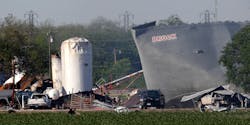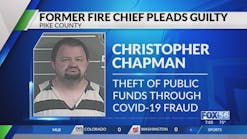Feds Critical of West Firefighters' Tactics at Plant Blast
Source Houston Chronicle
WACO - When the U.S. Chemical Safety Board came to town Thursday to adopt its final report on the West Fertilizer explosion, Phil Calvin wanted to make sure it made some small changes - things he said would mean nothing to anyone but him.
The report said his son had only three years of firefighting experience. Calvin fought back tears as he told the board his son actually had 17.
As they approach the three-year anniversary of the blast, some West-area residents found the CSB report painful to digest. It points to a lack of training among the first-responders and notes that West should have had zoning to prevent it from growing ever closer to the plant, which decades ago was far from the edge of town.
"I applaud the work they do," Calvin said of the CSB. "It's just when it comes to fighting fire, they're not firefighters. When it comes to fertilizer, I've been dealing with it 55 years."
State and federal agencies are now tasked with responding to CSB recommendations for better ammonium nitrate storage and inspections, and improved firefighter training.
The fertilizer component is a staple crop treatment, especially across the South in rural areas often served by volunteer fire departments. The CSB found those departments were given conflicting information, if any, about the hazards of ammonium nitrate. In West, the responding firefighters weren't aware of its explosive potential. And they didn't adhere to national incident response standards developed after 9/11, standards that could have led them to stand down and let the fertilizer plant burn, while residents evacuated.
Phil Calvin, 69, said his son and the other first-responders didn't have enough time to contemplate those standards - the plant exploded just 14 minutes after the first 911 call.
Perry Calvin, 37, was a volunteer firefighter for Navarro Mills, some 30 miles away. He was attending an EMT training class in West when he heard the call for help. He was one of 15 who died that day.
For most of his life, he and his father traveled around Texas selling hay. They had been around ammonium nitrate fertilizer all their lives, farming their fields and cattle. When Perry was a boy, Phil would send him up to the back of the fertilizer truck to stomp apart clots of the little white pellets.
Today, Phil hires out his farming.
"Perry was always in the field," he said. "It was too hard to go back."
Hundreds of West-area residents have stories like the Calvins' - of lives taken away or changed, homes that were demolished or no longer feel the same.
The CSB report has major implications for the entire U.S. chemical industry, finding fault with multiple state and federal agencies and holes in regulations that allowed one of the state's worst industrial accidents to kill so many people, injure hundreds and level much of a town.
It should have been prevented, and something like that should never happen again, the board said.
A new Texas law gives fire officials authority to inspect and cite fertilizer facilities for hazardous conditions, and the state fire marshal's office said it plans to start inspections this spring.
But the CSB has no enforcement authority, and chemical accidents of all kinds will continue to happen unless federal agencies do a better job enforcing existing laws for all chemicals - not just ammonium nitrate, said Sam Mannan, director of the Mary Kay O'Connor Process Safety Center at Texas A&M University.
"It seems to me all our efforts in chemical safety are reactive, and we are literally running from disaster to disaster without a well thought-out plan," Mannan said.
Vanessa Sutherland, the chairperson of the CSB, unveiled the agency's 265-page final report on the accident and encouraged everyone to respond to the recommendations.
Gaps in regulatory oversight must be closed, communities must be better prepared and companies must take the right steps to improve safety or "it is possible for another incident like this to happen," she said.
Johnnie Banks, the supervisory investigator, said it was a "long and incredibly, technically challenging" investigation, which is why it took nearly three years to complete.
The report describes failures by the West Fertilizer Company, the government, fire officials, insurance companies and others.
The blast destroyed homes, schools, apartments and a nursing home. Had it happened earlier in the day, with school in session, hundreds more people would likely have been killed and injured, the CSB concluded.
Fire investigators narrowed the cause of the blast to three possibilities: electrical wiring, a short-circuited golf cart or arson.
Lawsuits involving hundreds of plaintiffs, including the city of West, remain pending against the plant owners and fertilizer suppliers. The blast caused an estimated $230 million in losses. West Fertilizer is no longer in business.
The CSB found that almost all Texas fertilizer plants like the one that exploded are within a quarter-mile of a residence, and little has been done to protect those people.
The agency recently decided to launch a study on the threat of hazardous materials located close to the public. Sutherland said that decision was driven by the fact that 13 past investigations have involved facilities near homes and the threat of a large-scale disaster is still present.
———
©2016 the Houston Chronicle
Visit the Houston Chronicle at www.chron.com
Distributed by Tribune Content Agency, LLC.






